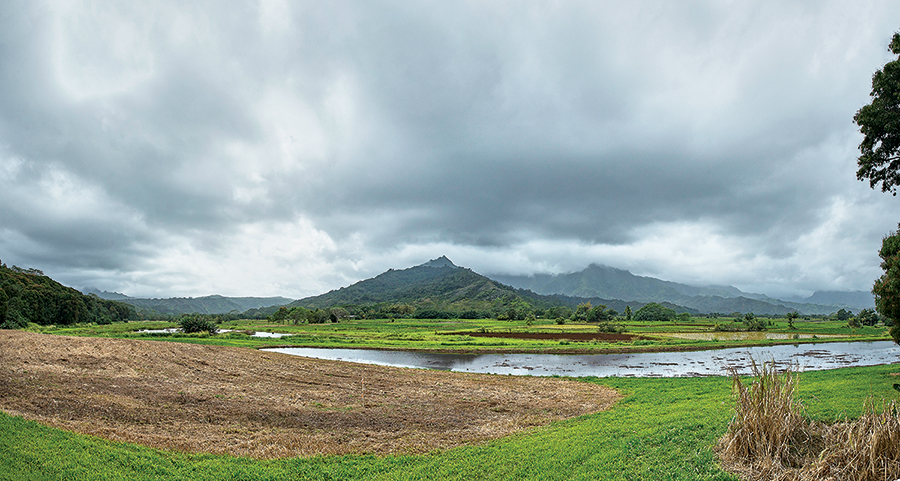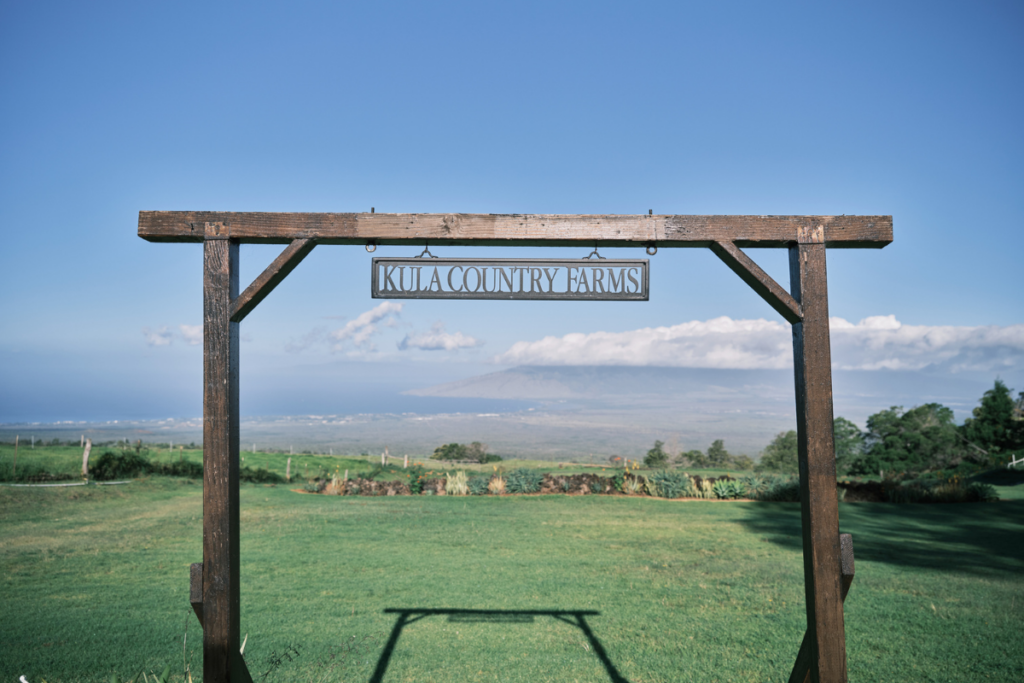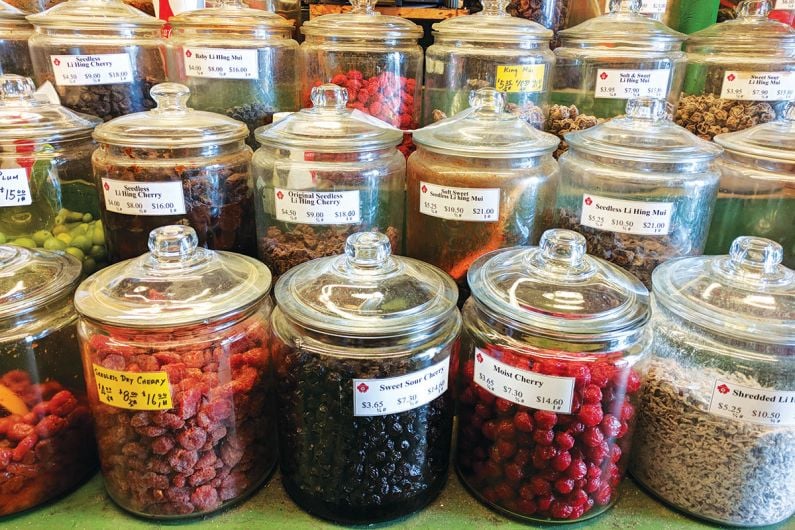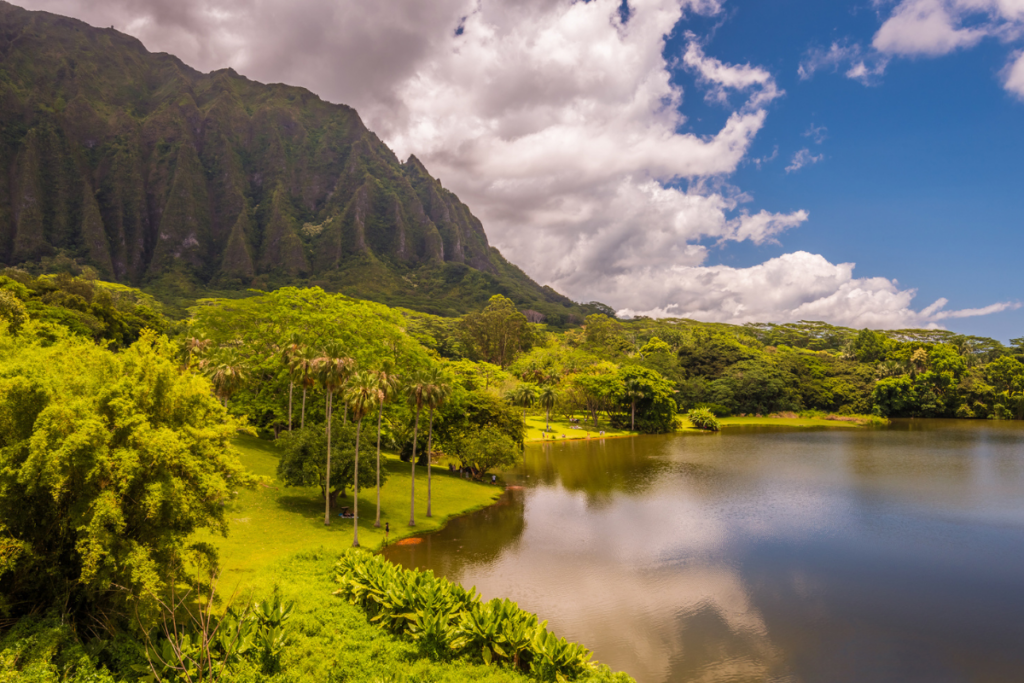Birdland

Puttering through an encroaching thicket of grasses, the open-top Hummer I’m riding in eases into a clearing alongside a large pond within the Hanalei National Wildlife Refuge. Locked in on our target, refuge engineering equipment operator Chadd Smith moves the vehicle ever closer to a motionless pair of nēnē, nestled in a lone plot of tall, invasive California grass.
“These nene will let you get really close,” says Smith.
Hawaii’s state bird had all but vanished from Kauai before 50 individuals were reintroduced into the wild in the 1990s. It’s my first time spotting the endangered, endemic Hawaiian goose and I’m transfixed.
Still, as our vehicle approaches, something feels off. The nene are too still, the grass around them, too high. Smith chuckles. Suddenly I realize they are decoys.

When I shift my gaze to take in more of the field around us, my excitement jumps again. Dozens of the grey-and-white-patterned nene, unmistakably live, are nibbling on young grass shoots, their black heads bowed.
“It’s like the field of dreams,” says Smith, of the golf-course-short lawn the geese are grazing on. From the back of the Hummer, Mike Mitchell, acting project leader of all three of Kauai’s National Wildlife Refuges, agrees.
“It’s just another example of ‘build it and they will come,’” Mitchell says to me before offering a suggestion to Smith.
“I guess you can take out your decoys now.”
The 917-acre Hanalei National Wildlife Refuge, situated a few miles east of its namesake north shore Kauai town, is one of Smith and Mitchell’s outdoor offices. My ride-along with the dynamic duo, cruising through the refuge’s fields and wetlands in a U.S. Fish and Wildlife Service Hummer, is something few ever experience. Save for a single road running through its center allowing access to nine family-owned kalo (taro) farms that share the property, Hanalei NWR has remained closed to the public since its 1972 refuge designation to minimize disturbance to its birdlife.

Smith, Mitchell and two other Fish and Wildlife employees divide workdays and schedules between the Hanalei, Kilauea Point and Huleia National Wildlife Refuges. It’s a lot of ground to cover. But what the bare-bones staff has accomplished in recent years behind the Hanalei refuge’s closed gates is remarkable.
An 80-acre management plot within Hanalei NWR, plagued by a scourge of neck-high California grass a decade ago, now serves as forage, breeding and nesting habitat for ample populations of the state’s five endemic wetland bird species: koloa maoli (Hawaiian duck); aeo (Hawaiian stilt); alae ula (Hawaiian moorhen); alae keokeo (Hawaiian coot); and nene. Among the rarest of these are the koloa.
Since the early 20th-century peak of Hawaii’s sugar-plantation era, the Islands have lost nearly 97 percent of their original wetlands, the koloa maoli’s preferred habitat. Interbreeding with their look-alike mallard cousins has also altered the koloa maoli gene pool. Within Hanalei NWR, however, annual counts have notched a 554 percent jump since 2006. The Fish and Wildlife Service estimates that the refuge now supports nearly half of the world’s genetically pure koloa maoli population. Thirty-five percent of that population maintains year-round residency at Hanalei NWR and Mitchell says we’ve likely seen at least that many already.

a sight virtually inconceivable just a decade ago.
Smith soon drives us into another clearing, surrounded by mountains capped by low hanging clouds.
“This area was a forest two years ago,” says Smith. “There were 200 30-year-old plum trees and hau bushes between them. [It was so thick] we didn’t even know where our property line was.”
Today, in place of the invasive flora, a meadow surrounds a large, shallow pond dotted by several large tree trunks, intentionally placed by Smith. As we approach, four koloa take flight, circle the pond and return again to float near some reeds. Two alae keokeo rest atop one of the tree trunks, near a patch of native sedges. We hear the cry of fighting aeo before witnessing their standoff, both atop laughably long legs. A cluster of shy but instantly recognizable red-crested alae ula wades on the far side of the pond.
“This is the only place in the world that you can come and see these four endangered water birds right in one spot,” says Mitchell of the refuge.
In 2005, Smith and Mitchell changed their management strategy. Smith went to work dividing the refuge into 30 distinct wetland units he continues to manage on rotating 18- to 24-month cycles. They mow individual plots every two weeks, aerate and till the soil and carefully control water levels with a complex piping system drawing water from the Hanalei River, which runs through the refuge. Wetlands are left in various stages of succession, with Fish and Wildlife staff watching to see what the birds prefer. After eradicating most of the refuge’s California grass, they were surprised to find native plant species return.

“All we had to do was scrape off the non-native layer and the old seed bank was just here, waiting,” says Mitchell. “With the exception of a few lowland koa trees, we didn’t plant any of this.” When invasive plants begin to encroach, “I like to say we control this seven different ways: We mow it, disk it, till it, spray it, pull it out by hand, flood it and curse at it. A lot of cursing at it.”
Controlling the incursion of invasive predators also requires near-constant vigilance. On the morning we arrived, Smith had already been up since 3 a.m. walking the refuge perimeter and hunting wild pigs with a night-vision scope. Mitchell recalls an incident when he had to use ninja-like reflexes to catch a bullfrog, break its jaw and pry a fluffy baby alae ula from its clutches.
Their efforts have proved rewarding. In addition to the spike in koloa maoli, counts of other water birds in the Hanalei refuge’s annual surveys have also skyrocketed. Since their management strategy took effect a decade ago, nene counts in the refuge are up an average 550 percent, alae ula up 573 percent, aeo up 257 percent and alae keokeo up 111 percent.
As I climb off the Hummer at the end of our day, something Mitchell said earlier returns to my thoughts: “Our work is the melding of art and science.” I feel fortunate to have witnessed the work crafted by the hands of these landscape artists at Hanalei National Wildlife Refuge.
Their accomplishment is not just a home for rare birds, but a home built with rare determination.


